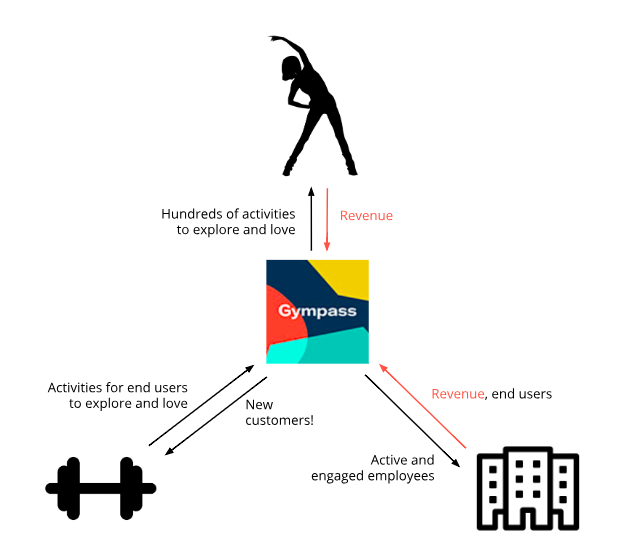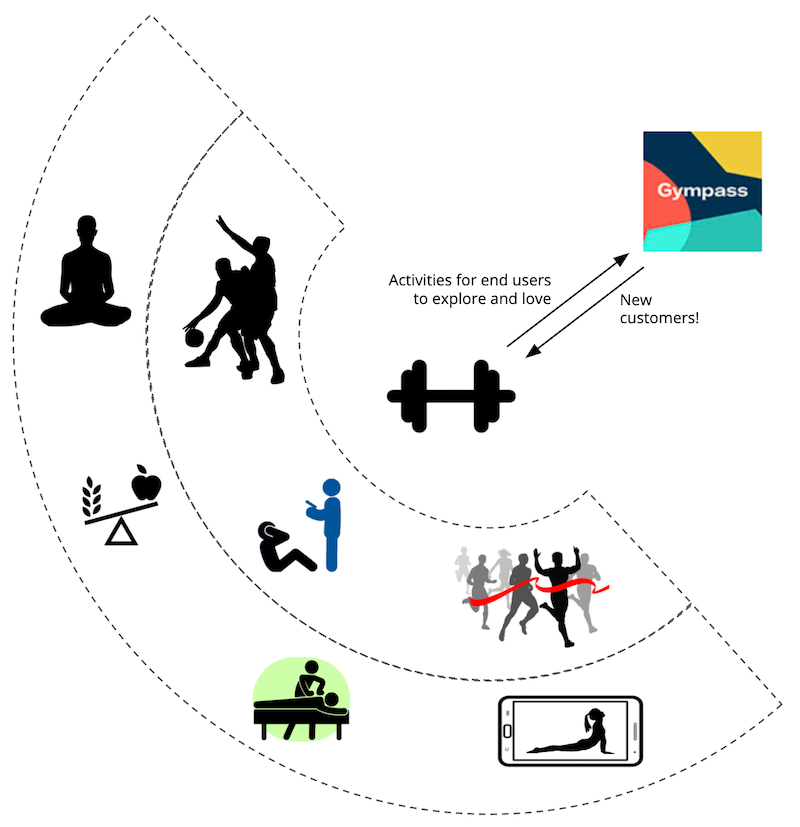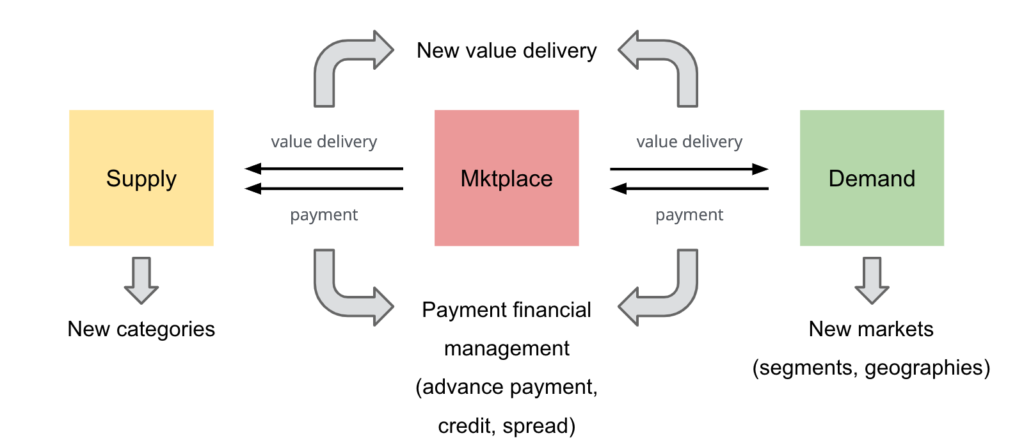The top-down trap
14 de June, 2020Stakeholder relationships
28 de June, 2020During the COVID-19 we did a diversification – and digitalization – of our product portfolio in record time. We went from one offline product, access to gyms and studios, to 4 products, 3 of them fully digital, in less than a month:
- Access to gyms and studios: access to more than 50,000 gyms and studios in 14 countries;
- Live classes: for those who like to train in groups or want to relive the feeling of class with colleagues at the gym;
- Personal trainers: for those who prefer a more personalized approach and like to exercise in their own time;
- Gympass Wellness: application package with more than 60 apps for those looking for options to improve physical and mental well-being (from nutrition to the therapy session).
In this article I’ll explain how we did it.
Product Vision
When I joined Gympass, in mid-2018, one of the first things I did was to build o product vision. We had a very compelling purpose, to defeat inactivity. However, in order to build a digital product, we need more than a purpose.

This vision guided the definition of Gympass’ product development organization. We built teams around each of the participants of the marketplace, plus a central team that worked on the payment flow collecting payment from companies and their employees, making all calculations and determining the payment for each gym partner.
When I was building this product vision and discussing it with different people in the organization, it was easy to see many opportunities to expand this marketplace. There is a lot of new categories supply we could add to our marketplace:

I’ve already explained the theory behind these ideais of marketplace expansion.

Given the above dynamic, we can expand a marketplace as follows:

However, we had a lot to do in our core product back then, so we didn’t have enough energy to focus on expanding our marketplace.
New venture
In October 2019 we got to a point where our product development team was well structured and working properly to address our challenges in our core product, so we decided to focus on expanding our marketplace.
We decided to work on an idea called “Gympass end-user partnership hub”. The plan was to partner with wellness apps and provide them our users.
This new idea had too main hypothesis we needed to test:
- willingness to partner from app providers. App providers, like gyms, are used to the recurring monthly revenue model. Are they ok to be paid by the day of use?
- willingness to pay from our user base. Is our user base interested in paying a monthly fee to have access the apps?
To test our first hypothesis we built a deck with the value proposition we were planning to deliver to the partners and talked to some potential partners. We presented the partnership opportunity to 8 potential partners, from which 6 showed interest and 4 decided to join our proof of concept. NEOU, a workout app, 8fit, a workout and nutrition app, Tecnonutri, a nutrition app and ZenApp a mindfulness app.
Ok, our first hypothesis was validated and we needed to validate the second hypothesis, the willingness to pay. Are our user willing to pay to have access to this apps through Gympass?
To test our second hypothesis, we built a simple form, where we describe the product and asked name, email, and company. After the user gave this information, he was directed to a Paypal subscription page, where he need to provide credit card information to subscribe to the service. The user received an email with the activation link for each app. There was no real product, just a form to test interest and email with the links to the apps. Check out the experience below:
We initially called it Gympass W, the W standing for wellness. We added a beta so everyone could understand that it was not a finished product. Later we renamed it to Gympass Wellness to make its value proposition more clear.
Our plan was to test this proof of concept with 5 corporate clients in the US and 5 in Brazil, which would provide us a combined user base of 15,000 employees. Our expectation was to have around 200 subscribers. We launched internally – eat your own dog food – on March 9th and we got 66 subscribers. Then came COVID-19.
COVID-19
As I already explained in a previous article, when a business is hit by a crisis, it needs to look into these two perspectives:
- preserve cash;
- identify and adapt to changes in customer problems and needs.
Even though product managers and product development teams have an important role in the former, their main role is in the latter.
Here at Gympass we have 3 different customers and all of them deeply impacted by COVID-19:
- gyms in many cities were closed to help in physical distancing measures applied in many cities to avoid the spread of COVID-19 and consequently are losing recurring revenues from users who are not visiting the gym;
- users, the employees of our clients, cannot go to gyms anymore and have to stay at home, but also have to somehow stay active, but their first reaction is to cancel or pause their Gympass membership since they won’t have access to gyms for a while;
- corporate clients, whose employees are at home and don’t go anymore to gyms, while HRs are concerned about how to keep these employees engaged and productive.
Gympass Wellness, the first digital product
We were able to adapt our Gympass Wellness pilot in record time to be offered to our entire user base so they can not only remain active but also take care of their nutrition and their minds during these very challenging times. With Gympass Wellness we were able to address both users and our corporate clients’ changing problems and needs during the crisis.
We have a corporate value that I believe all marketplaces should have, Ecosystem Mindset. This means that we should always look to all participants in our marketplace and guarantee that all benefit from using it.
Live Classes, the second digital product
With Gympass Wellness, we were able to address the needs of our corporate clients and their employees. What about the gyms? By being closed, they were losing revenue. Their customers were not visiting them anymore so the regular gym users were prone to cancel their subscription while those who used to visit gyms using Gympass wouldn’t visit the gym during the crisis what would cause a loss of revenue for the gyms as well. To help our partner gyms we decided and implemented in record time 2 solutions:
- Provide gyms a white label app they could offer to all their members so they can deliver value to their clients helping them stay active while at home;
- Provide a platform for gyms to schedule and stream live classes to all Gympass users so they can keep their instructors employed while providing Gympass users with exclusive content. This platform is called Live Classes.
Personal Trainers, the third digital product
Live Classes provided a platform 1:N, meaning one instructor could provide physical activity guidance to N users. We soon realized we could create another product on top of Live Classes, 1:1 physical activity guidance, which could be made available in Gympass’ higher-tier plans. We then created our third digital product, Personal Trainers.
Summary
- Even though we had the vision of expanding our supply offer beyond physical gyms and studios quite early in our journey, we needed to have our core product stable in order to invest in this expansion.
- Back in November 2019, we started to create our first digital product, Gympass Wellness, in a regular pace, creating controlled tests to validate or invalidate hypotheses.
- COVID-19 dramatically increased the need for speed in developing new digital products. We went from 1 offline product (access to physical gyms and studios) to 4 products adding Gympass Wellness, Live Classes, and Personal Trainer to our product portfolio in 2 months. Prior to the crisis, this diversification and digitalization would probably have taken 2 to 3 years.
Digital Product Management Books
Do you work with digital products? Do you want to know more about how to manage a digital product to increase its chances of success? Check out my new bundle Digital Product Management with my 2 books where I share what I learned during my almost 30 years of experience in creating and managing digital products.

